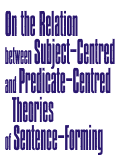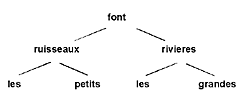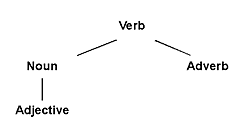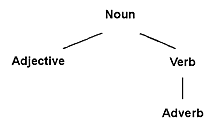 | ||
|
Fais ce que doit, advienne que pourra | ||
|
Карьера | English | Разное | Интересы | Публикации | ||
 |
On the Relation Between Subject-Centred and Predicate-Centred Theories of Sentence-Forming (V.Mathesius and L.Tesnière) by Valerij Danilenko (Leningrad) Philologica Pragensia, 1988, №1 The comparison of scientific theories may be carried out in two directions. Firstly, the theories may be compared on the whole. Secondly, they may be compared on the level of a certain aspect of a theory. We analyze here L.Tesniere's and V.Mathesius' theories on the level of subject-centred and predicate-centred approaches to the sentence-forming. The relation between L.Tesnière and V.Mathesius cannot be reduced to the formula "subject-centred - predicate-centred", this formula, however, can serve as the point of departure in the analysis of any theory of sentence-forming. The aim of this article is the comparison of L.Tesnière's and V.Mathesius' theories in their relation to the given formula. The first theory is predicate-centred; the second one is not only predicate-centred, but also subject-centred. In other words, L.Tesniere's theory is monocentrical, whereas V.Mathesius' theory is bicentrical. Our article is devoted to the explanation of this fact. It is well-known that the subject-centred theory of sentence-forming emphasizes the priority of the grammatical subject in the organization of the sentence, the predicate-centred theory, on the contrary, places the main emphasis on the grammatical predicate. The predicate-centred theory is also interpreted as verb-centred theory, due to the fact that a finite verb is usually used as the predicate. While the subject-centred theory is of a traditional nature, the predicate-centred theory is considered as relatively new despite the fact that it originates from the 18th century grammar (Kuznecov S.N., 1984, p. 7). The development of the verb-centred theory in the 20th century is connected with the theory of sentence stemma elaborated by L.Tesniere (Tesniere L., 1965). According to L.Tesnière, "stemma" is a state of the sentence prior to its "linear order", the state implying a complete grammaticalization of all the members of the sentence. "To construct or establish the phrase stemma" (as L.Tesnière puts it) "means to convert the linear order into a structural one. Consider the following phrase: Les petits ruisseaux font les grandes rivieres "Little brooks turn into large rivers". Converting the linear order into the structural one gives the stemma of the following type:
...to speak the language means to transform the structural order (the sentence stemma, or tree - V.D.) into the linear one, and, on the other hand, to understand the language means to convert the linear order into the structural one” (Tesnière L., 1965, p. 19). L.Tesnière treats the predicative verb as the grammatical centre of the sentence. According to L.Tesnière, the speaker focuses upon the action in the situation which he describes. Consequently, the verb must play the main role in the stemma formation: it denotes the action as the centre of the situation, while the other members of the sentence designate the participants ("actants") of the action and their features ("attributes") or the circumstances ("circonstances") where the action takes place. V.Mathesius did not use the term "stemma", but he made use of the notion implying this term. He adheres to the subject-centred theory of stemma formation. According to him the speaker treats the situation to be described subjectively: he may focus not only on the action but also on the actants with their attributes and the circumstances during the stemma formation. While L.Tesnière's basic stemma of the sentence is as follows:
Mathesius'basic stemma looks differently:
The theories of both L.Tesnière and V.Mathesius seem to reveal the discrepancy between the predicate-centred and subject-centred theories of sentence formation. The relations between these theories, however, are not so straightforward as one might think. As a matter of fact, in the structural section of the grammar V.Mathesius places the main emphasis upon the verbal predicate as the centre of sentence formation, while in the functional section of the grammar the subject is considered as the centre of the sentence formation. It is not a discrepancy. The structure of linguistic activity of a speaker, which is aimed at the concrete utterance, is the base of V.Mathesius' "functional" ("onomasiological" in our terminology) grammar. The process of the utterance generating was divided by V.Mathesius into two acts. "By the one, elements are selected from the given reality, concrete or abstract, which fulfil the double condition of having focussed the attention of the prospective speaker and of being able to be expressed by means of the vocabulary existing in the given language (this act is the base of V.Mathesius' "functional onomatology" - V.D.); by the other, the linguistic signs representing the selected elements are put into mutual relations so as to constitute an organic whole, a sentence (this act is the base of V.Mathesius' "functional syntax" - V.D.)" (Mathesius V., 1936, p. 308). V.Mathesius did not include onomatology in syntax, but his grammar is syntactical on the whole. The scholar, in the end, regarded the lexical and morphological nomination as the initial periods of sentence formation. During the lexical nomination the speaker selects the lexical units for the sentence. During the morphological nomination he begins to grammaticalize the lexical units. These two periods compose the first stage of sentence formation. In its turn, the second stage of sentence generating is divided into two periods. The first consists in the subsequent grammaticalization of the lexical units and, consequently, in the completion of the sentence stemma. The second period consists in the linearization of the stemma. In this period a speaker also produces the functional sentence perspective. The theory of functional sentence perspective therefore completes V.Mathesius' grammar as a whole. As was mentioned earlier (Danilenko V.P., 1986a; I986b), the onomasiological principle plays the main role in V.Mathesius' "functional grammar". This principle may be expressed in the following way: extralinguistic content (reference) -> linguistic form/language system – speech. The onomasiological ("functional" in V.Mathesius' terminology) grammar is based on the need of the speaker who has to transform extralinguistic content into linguistic form. This aspect of speech activity builds up the structural section of the onomasiological grammar. The functional section of this grammar is concerned with another aspect of speech activity. It deals with the transformation of linguistic elements chosen by the speaker out of the language system into the concrete utterances (speech). The structural section of onomasiological grammar is aimed at the systematization of semantic structures of language, while the functional section of this grammar studies the functioning of linguistic structures in the activity of a speaker. The peculiarity of semantic structures is that they are composed of a certain number of formal structures, which are studied in the semasiological grammar. The semasiological ("formal" in V.Mathesius' terminology) grammar is based on the following transitions: speech (utterances) -> language system/linguistic form - extralinguistic content. The structural section of semasiological grammar reflects the first of these transitions and is aimed at the systematization of formal structures. The functional section of semasiological grammar reflects the other transition and studies the functioning of the given structures in the activity of a hearer. V.Mathesius' grammar is characteristic of both the structural and the functional sections of onomasiological grammar. The structural section of V.Mathesius' syntax contains the classification of semantic sentence structures. V.Mathesius distinguished four types of these structures - actional, qualifying, existential, and possessive types. The first type covers those sentences whose predicate implies action. The other three types are based on the categories of qualification, existence, and possession. Each semantic structure of the sentence contains various formal structures of the sentence. Thus, the actional structures include active, passive, and reflexive constructions (Mathesius V., 1961). However, the predicative verb in V.Mathesius' classification of semantic sentence structures is in the centre of the classification. F.Daneš and his coworkers also used the predicative verb ("predicator") as the basis of their onomasiological classification of sentences (Danes F., Hlavsa Z. a kol., 1981). While V.Mathesius' classification of sentences is of a predicate-centred character, K.Sunden's is based on the subject-centred conception (Sunden K., 1916). Semantic functions of the grammatical subject are within the range of interest of the Swedish scholar. If the grammatical subject denotes the agent then "non-converted predication" takes place. If the grammatical subject denotes the patient then "converted predication" takes place. Provided grammatical subject denotes the agent which at the same time is the patient the "middle predication" is implied. In the field of structural onomasiological syntax the predicate-centred theory of sentence formation is more effective than the subject-centred theory. This is due to the fact that this section of syntax regards the initial - prior to the grammaticalization of the lexical state of the generated sentence - period of sentence formation. In this period the speaker chooses the semantic sentence structure but not the formal one. It is the predicative verb that embraces various formal structures to be used for generating a single semantic structure. It means that during the period prior to the stemma formation we deal with pregrammatical (lexical) predicate. Otherwise it would have been impossible to prove the effectiveness of subject-centred theory in the field of stemma formation where the grammaticalization of predicative verb occurs due to substantive subject. V.Mathesius did not believe the formation of subject-predicate relations between the main parts of the sentence to be a simultaneous process. The starting point of the formation is the selection of predicative relation which is usually expressed by the verb during the lexical nomination and continued during the morphological nomination when the problem of the subject choice is faced. That is why V.Mathesius' classification of semantic sentence structures is based on predicative relations between the parts of the sentence as such, active and passive constructions being interpreted as formal structures included in semantic sentence structures. While K.Sunden places the main emphasis on the subject as the principal element of the sentence, V.Mathesius emphasizes that the predicate is the centre of the initial organization of sentence. During the period prior to the stemma formation we deal with the predicate when it has not been materialized grammatically. Let it be lexical predicate. The grammaticalization of this predicate is materialized in the stemma formation phase of sentence-forming. The choice of the lexical predicate is made by the speaker during the lexical nomination. At the same time, using lexical predicate the speaker may choose a certain semantic sentence structure (e.g., the actional one). During the morphological nomination the agent can be expressed as the grammatical subject and therefore active form of the verb must be used (Workers build a house). But the agent can also be expressed as the grammatical object and in this case passive form of the verb is to be used (A house is built by workers). During the morphological nomination the lexical predicate undergoes only initial grammaticalization. That is why during the stemma formation the role of grammatical subject is superior to that of the grammatical predicate. The grammatical subject is the head of the stemma of sentence, while the lexical predicate is the head of the semantic sentence structure which is selected by the speaker before the grammaticalization of the sentence. As for the stemma formation, it is the grammatical subject that determines selection of the concord categories of the attributive adjective and the predicative verb. According to V.Mathesius, the concord categories of the verb include the categories of gender, number, and person. These categories perform syntactic functions in the sentence but not onomatological (nominative) ones. They demonstrate the grammatical subordination of verbal predicate in relation to the substantive subject, but they do not express any extralinguistic content. The latter can be expressed by the corresponding categories of personal pronoun or noun (V.Mathesius believed that nouns possess the category of the third person). The category of voice is of paramount importance. V.Mathesius treats it as a morphological and a syntactical category. Its morphological character can be explained by regarding the voice as an aspect modification of the verb. There is a contrast between the reflexive forms of the verb and its active or passive forms which is rooted in the nature of actions denoted by these forms. The reflexive forms denote actions performed by the subject of action which is simultaneously the object of their actions. Active and passive forms denote actions directed towards being external to the agent. The choice of forms mentioned depends on the speaker's point of view of the situation described. If the speaker looks at the situation with the eyes of the agent "the active perspective of sentence" is implied, if he regards the situation from the point of view of the patient "the passive perspective of the sentence" is implied (Mathesius V., 1947, p. 294). In the former case the speaker uses the grammatical subject to denote the agent, in the latter he uses the grammatical subject to denote the patient. The choice of the voice forms therefore is determined by the grammatical subject's function: in the former case active voice is involved, in the latter case passive voice is used. This means that the category of voice is not only an aspect modification but also a concord category. The concord nature of the active voice forms is connected with the agent function of the grammatical subject, while that of the passive voice forms is derived from the patient function of the grammatical subject. Unlike L.Tesniere, V.Mathesius adhered to the subject-centred theory of sentence grammaticalization. He did not ignore the central role of predicate when the problem of the choice of semantic sentence structure is faced, but at the same time he emphasized the central role of the subject in the process of grammaticalization of the sentence. The predicate depends on the subject only due to the concord categories of the verb. This sort of dependence is manifested during the period of final grammaticalization of the predicate. During the morphological nomination lexical predikate undergoes only initial grammaticalization. Forming of the morphological traits of predicative verb is taking place in the speaker's brain without the connection with the morphological meanings of substantive subject. Grammaticalization of the verb during morphological nomination is the result of reflection of the onomasiological categories connected with tense, aspect, and mood in the speaker's consciousness. Onomasiological approach to the study of relationship between predicate- and subject-centred theories enabled V.Mathesius to determine the role of each theory in the process of sentence-forming. The former theory is effective in structural onomasiological syntax, the latter is relevant in functional onomasiological syntax. The interpretation of structural onomasiological syntax in terms of the subject-centred theory (K.Sunden) does not take into account the constitutive role of lexical predicate in the speaker's choice of semantic sentence structures. The interpretation of grammaticalization process in terms of predicate-centred theory, which is characteristic of functional onomasiological syntax (L.Tesnière), does not involve the dynamic character of speech activity in the process of grammaticalization. During the phase of grammaticalization of the sentence the speaker's point of view may be directed not only to action, but also to any other element of the situation to be described. In this period the element serving as the basis of the grammatical subject is perceived by the speaker as the subject of his thought, while the basis of the grammatical predicate is taken by the speaker as the most important feature of the subject of his thought. During the linearization of the stemma the relations mentioned above can be changed. This is determined by the factor of functional sentence perspective: the most important element of the situation can be denoted by any member of the sentence. However, it demands special means (word-order, intonation, etc.). Thus, the subject- and predicate-centred theories of sentence-forming are by no means contradictory, they can be considered to be interrelated. This, however, is possible when thejelevance of each of these theories is quite clear within the framework of the grammar serving the speaker's needs. References Danes F., Hlavsa Z. a kol., 1981. Veins vzorce v čestine (Sentence Patterns in Czech), Praha. Danilenko V.P., 1986a. „Onomasiologiceskaja suscnost' koncepcii funkcionaTnoj grammatiki Vilema Matesiusa" (Onomasiological Essence of Vilem Mathesius' Theory of Functional Grammar). Filohgiceskije nauki 1, 62 - 66. -. 1986b. „Lingvisticeskaja charakterologija v koncepcii V. Matesiusa" (Linguistic Characterology in V.Mathesius' Conception). Voprosy jazykoznamja 4, 120-128. Kuznecov S.N., 1984. Teoreticeskaja grammalika datskogo jazyka. Sintaksis, (Theoretical Grammar of Danish. Syntax), Moskva. Matbeaus V., 1936. "On Some Problems of the Systematic Analysis of Grammar". J. Vachek, A Prague School Reader in Linguistics. Bloomington, 1964, p. 306-319. Mathesius V., 1947. „Vyjadfovani pasivni perspektivy v ceske vete" (Expression of Passive Per in Czech Sentence). Cestina a obecny jazykozpyt, Praha, 294 - 301. - 1961. Obsahovy rozbor současne angličtiny na zadklade obecne lingvistickem (English translation A Functional Analysis of Present-Day English on a General Linguistic Basis 1975), Praha. Sunden K., 1916. 1. The Predicational Categories in English, Uppsala. Tesnière L., 1965. Éléments de syntaxe structural, Paris. V.P.Danilenko: К VZAJEMNYM VZTAHUM SUBJEKTOCENTRICKE A PREDIKATOCENTRICKE TEORIE TVORENI VETY (V.MATHESIUS A L.TESNIERE) Obe teorie - subjektocentricka i predikatocentricka - jsou opravnene, jestlize se uvadeji do vzajemneho vztahu s ruznymi fazemi procesu tvořeni vĕty. Prvni z nich odrazi predgramatikalizačni fazi v aktu odvozovani vĕty, druha gramatikalizačni. В.П.Даниленко: К СООТНОШЕНИЮ СУБЪЕКТОЦЕНТРИЧЕСКОЙ И ПРЕДИКАТОЦЕНТРИЧЕСКОЙ ТЕОРИЙ ФРАЗООБРАЗОВАНИЯ (В.МАТЕЗИУС И Л.ТЕНЬЕР) Обе теории - субъектоцентрическая и предикатоцентрическая - являются правомерными,если они соотносятся с различными фазами в процессе образования предложения. Первая из них отражает предграмматикализационный период в акте фразообразования, вторая - грамматикализационный. Philologica Pragensia, 1988, №1 | |
| Учеба: | ||
| Галереи: | ||
|
| ||
|
© Valery Vron 2002 | ||


